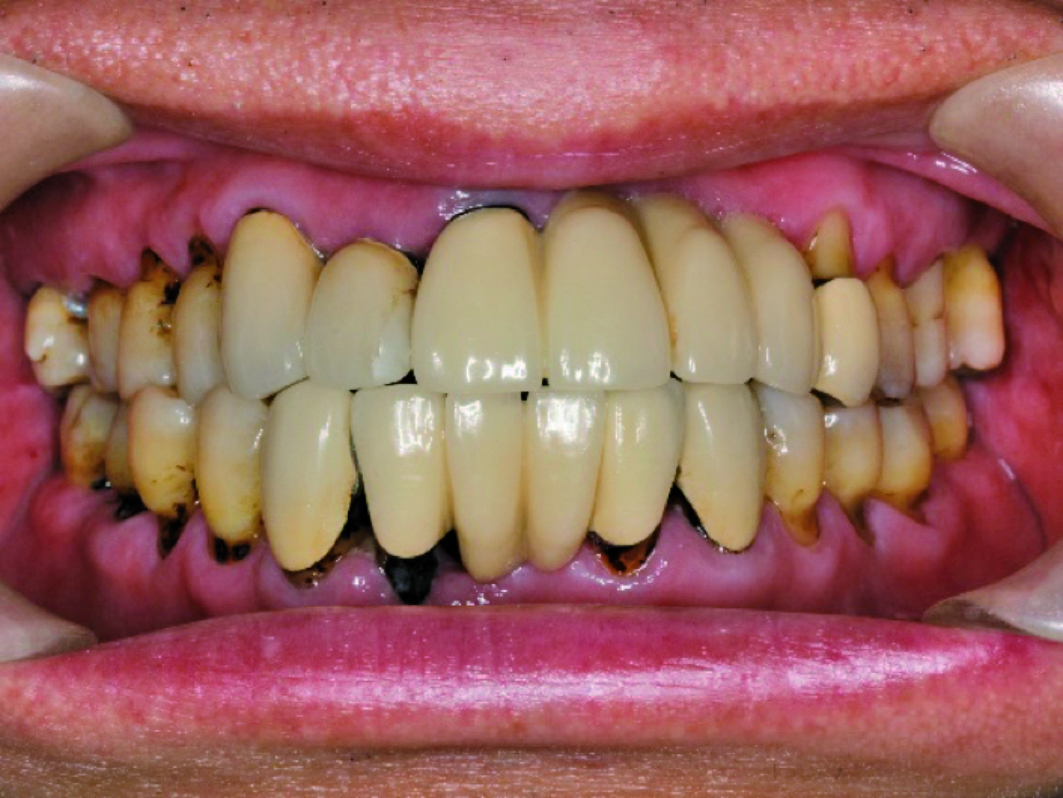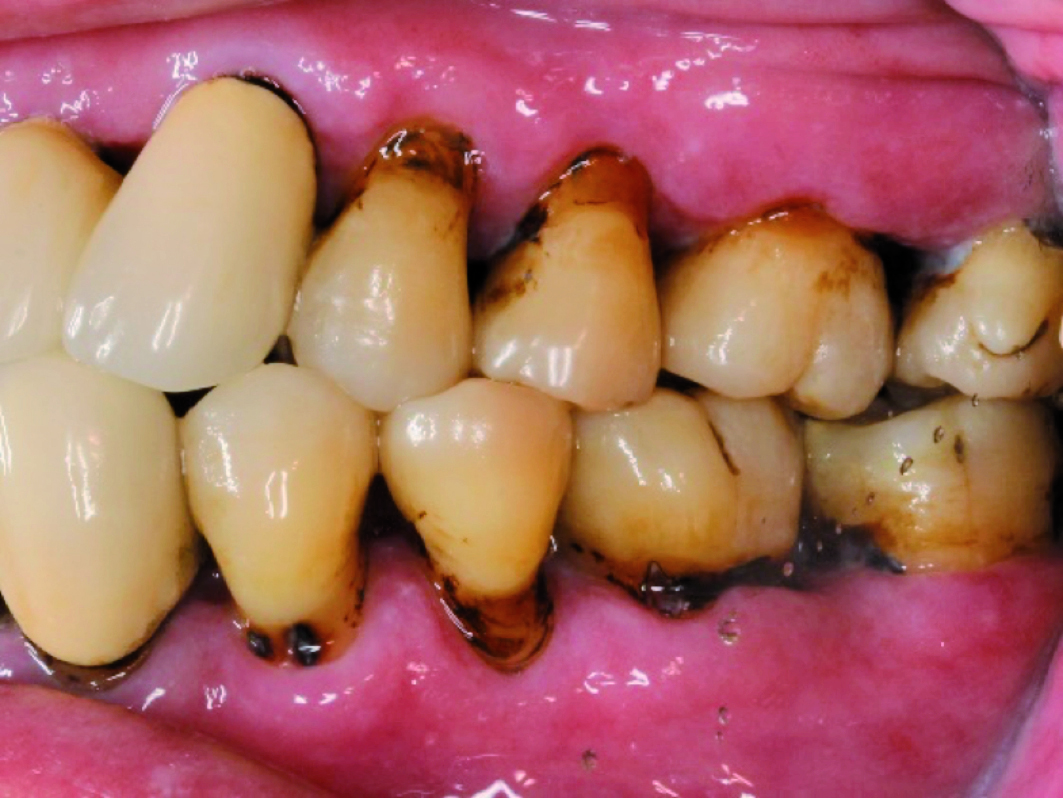

Clinical Professor, Faculty of Dentistry, The University of Hong Kong
The role of fluoridated toothpaste in the prevention of dentin caries, also known as tooth decay, is undeniably substantial for its well-documented contribution to the decline in tooth decay. The risk of caries is determined by different risk indicators, such as unrestored caries, extensive restorations, dry mouth, dental brace application, etc. Despite the preventive benefit is evidenced by research, high caries risk patients cannot benefit much from 1,450 ppm fluoride toothpaste. In light of this, high-fluoride toothpaste with a fluoride concentration high as 5,000 ppm was developed to address this issue and clinically proven to effectively control caries across patients of different age groups, especially the elderly1,2.
| Age | 55 |
| Gender | Male |
| Underlying medical history | Received radiotherapy for Nasal pharyngeal carcinoma |
| Clinical presentations |
• Reduced salivary flow (dry mouth) • Dentin hypersensitivity (sharp pain) during consumption of sweet or sour food and beverages • Multiple soft/active root caries |
| Treatment objectives |
• Alleviate dry mouth • Relieve dentin hypersensitivity • Control root caries |
| Treatment received |
Combination therapy • 25% silver nitrate solution • Duraphat® high fluoride varnish (5% sodium fluoride) • Daily home use of Duraphat® 5,000 toothpaste |
| Outcomes at 6-month follow-up |
• All soft/active root carious lesions were arrested and hard to probe • Absence of sensitivity pain |


In this case, tooth cavities and dry mouth concerned this 55-year-old male patient and prompted his visit to the dental clinic. For the management of tooth cavities, other than the combination therapy, integration of home care routine was recommended to help enhancing remineralization and strengthening tooth surface through brushing and smearing teeth with 5,000 ppm high-fluoride toothpaste thrice and twice a day respectively. On top of that, the patient was also advised to practice behavioral changes concerning his dry mouth - sipping water or sugar-free drinks throughout the day and drinking water to aid chewing and swallowing during meal. Although there was inevitable black staining from the silver nitrate therapy, the patient was very satisfied with the treatment outcomes at all as he was well informed by clinician prior to treatment initiation.
Dentin caries is a dynamic process of de- and remineralization and will progress upon the balance is lost towards demineralization. Current evidence suggests that high fluoride application can arrest caries at any stage of disease progression3. Multiple root caries was once challenging for dentists to manage back then for lesion extension into proximal and subgingival surfaces and unfavorable prognosis when high fluoride agents were not yet available. High fluoride varnish (5% sodium fluoride) monotherapy, however, may not be effective enough to arrest dentin caries without combined use of silver nitrate solution4. Clinical and laboratory studies have validated a potent remineralization effect of this combination (sodium fluoride varnish + silver nitrate) comparable to that of silver diamine fluoride in arresting dentin caries and reducing dentin hypersensitivity5,6. Furthermore, rapid relief of dentin hypersensitivity can also be achieved with this treatment protocol based on Prof. Chu’s first-hand clinical experience. Of note, this treatment protocol will stain the root caries areas a black color which clinician should best inform the patient about the side effect beforehand for successful expectation management.
To maximize favorable treatment outcome of the mentioned protocol, high-fluoride toothpaste is indeed an appropriate auxiliary treatment for patients with high caries risk, which requires minimal efforts from dental professionals along with enhanced values of easy administration and affordable cost. By increasing the fluoride concentration in toothpaste from 1,000 ppm to 5,000 ppm, the risk of root caries can be halved7. Besides, high-fluoride toothpaste at 5,000 ppm was found to promote remineralization of exposed root caries8. Frequent use of 5,000 ppm high-fluoride toothpaste (toothbrushing thrice and smearing on teeth twice a day) may helps maintaining salivary fluoride concentration at around 1 ppm throughout the day for preventive benefits.
Professional application of 25% silver nitrate with Duraphat® varnish followed by home use of high-fluoride toothpaste is an effective protocol to reduce the risk of root caries and provide sensitivity relief. Use of 5,000 ppm high-fluoride toothpaste as a home care routine is a justifiable measure for controlling root caries required the least effort from both clinicians and patients.
References
1. Walsh T, et al. Cochrane Database Syst Rev. 2019 Mar 4;3(3):CD007868. 2. Srinivasan M, et al. Community Dent Oral Epidemiol. 2014 Aug;42(4):333-40 3. Gao SS, et al. BMC Oral Health. 2016 Feb 1;16:12. 4. Chu CH, Lo EC, Lin HC. J Dent Res. 2002 Nov;81(11):767-70. 5. Gao SS, Lo EC, Chu CH. J Dent Res. 2017;96(Spec Iss B): S0001. 6. Zhao IS, et al. Int Dent J. 2017 Aug;67(4):206-214. 7. Ekstrand KR. Caries Res. 2016;50 Suppl 1:15-21. 8. Bizhang M, et al. BMC Res Notes. 2009 Jul 23;2:147.





